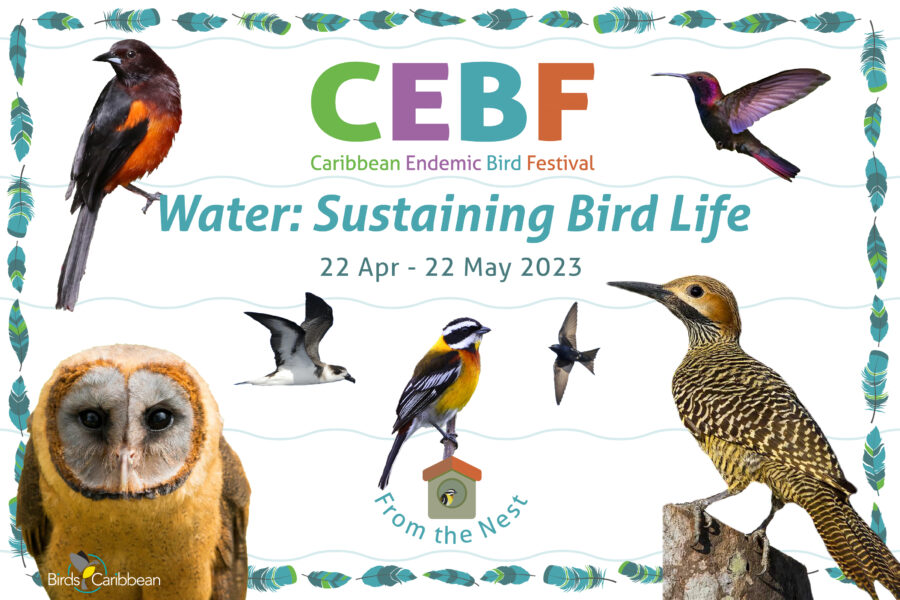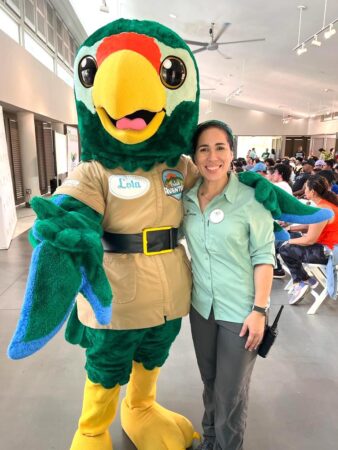
BirdsCaribbean is proud to coordinate the annual Caribbean Endemic Bird Festival (CEBF) along with many environmental and community organizations across the region. Today we look back on all the fun events celebrating the Caribbean’s iconic birds, being in nature, meeting new friends, and making water conservation an important part of our daily lives!
The Caribbean Endemic Bird Festival (CEBF) 2023 emphasized the importance of water conservation by shedding light on the crucial role of waterways and their surrounding watersheds in supporting our region’s unique bird populations and providing us with clean water.
We often see birds flying, preening, and feeding, but rarely do we see them drinking water. This does not mean that water is not important to birds. In fact, birds need water just as much as we do. Drinking water helps them regulate body processes like digestion. Water also keeps birds clean and cool on hot days when they take a splish-splash in a puddle, gutter, or backyard bird bath. Many birds also rely on wetland habitats, such as our ponds, salinas, marshes, mangroves, rivers, and coastal waters. With growing human populations and relentless development, there are growing demands for water and continued destruction of our remaining wetlands.
The 2023 CEBF marked a significant milestone in bird conservation efforts. After a challenging period of virtual celebrations due to the COVID-19 pandemic, this spring we witnessed a massive return of in-person activities. Bird enthusiasts, nature lovers, conservation organizations, and local communities all came together to spread the urgent message that water conservation is vital for all life on earth, including birds, and to learn how to protect the habitats of the one-of-a-kind bird species that call the Caribbean home.
CEBF heads offline and into nature
Coordinators embraced the theme by focusing on water as an essential resource and raised awareness about conserving and sustainably managing water habitats. The interconnectedness of birds, water, and the broader ecosystem was celebrated and supported through birdwatching trips, habitat cleanups, bird fairs and many more activities.
“Water, a lifeblood of our birds, sustains not only their existence but also their habitats,” said Eduardo Llegus, co-regional coordinator of CEBF. “With over 700 bird species in the Caribbean relying on our water resources, it becomes clear that the preservation of these precious resources is essential for their survival. As we embrace the UN Decade (2021-2030) on Ecosystem Restoration, let us remember that protecting and reversing degradation of our water ecosystems is not just an obligation but a lifeline for our avian treasures and the biodiversity they represent, hence, a healthier ecosystem and a healthier people.”
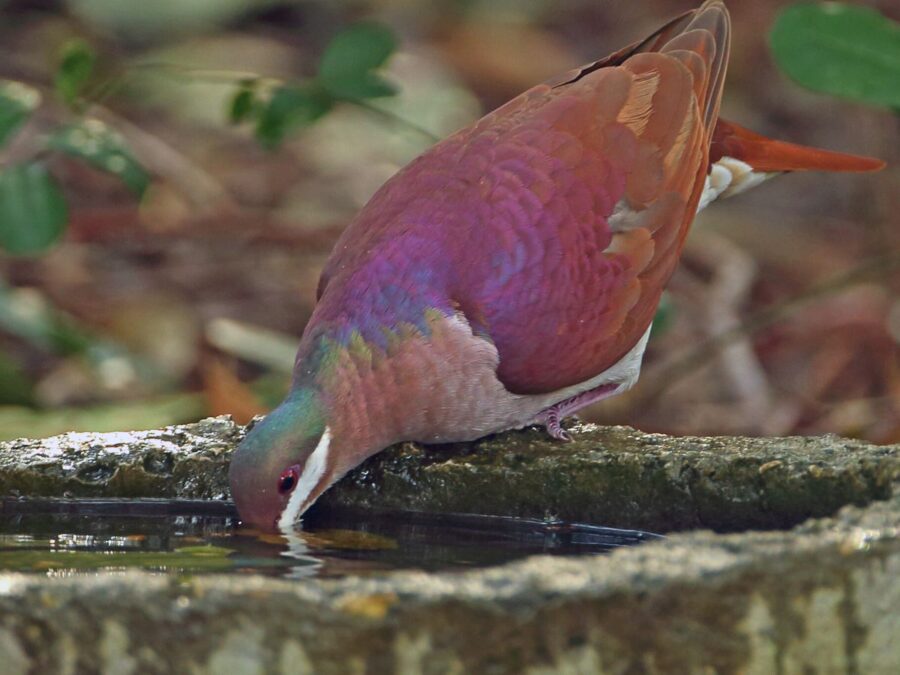
CEBF events were highly interactive and captivated children, teens, and adults alike. Birdwatching allowed attendees to marvel at the beauty and diversity of endemic bird species in their natural habitats. These guided field trips also provided valuable insights into the ecological, economic and cultural importance of natural areas. Educational workshops and presentations deepened participants’ understanding of birds and their conservation needs. CEBF island coordinators educated participants about bird ecology and behavior, raised awareness of the multitude of threats they face, and inspired individuals to become advocates for bird conservation.
Celebrations across the region!
Jamaica
Birdlife Jamaica organized a “Bring a Child Birding” event in Kingston’s vibrant Hope Gardens. Approximately 50 participants, divided into smaller groups, enjoyed a thrilling two-hour tour spotting many birds, including exclusive Jamaican endemics. Despite the busyness of the garden, they all enjoyed the experience and we hope these budding birders continue to be encouraged to bird. More details from this event will be shared in an upcoming blog!
Cuba
CEBF celebrations in Cuba were vast! An astounding 69 Cuban island coordinators executed a multitude of events across 12 (out of 15) provinces impacting over 5,000 people. This year we joyfully welcomed new Cuban birding clubs to the celebrations: Club Observadores de Aves de Artemisa, Club de Observadores de Aves de Granma, Proyecto comunitario Amiguitos de la Naturaleza, and Nativa Red de Microviveros. Cuban ornithologists Martín Acosta, Lourdes Mugica, and Karen Aguilar released a much-needed field guide, “Aves del Jardín Botánico Nacional” which documents the abundant bird life at Cuba’s National Botanic Garden. Children and teenagers were treated to bird puzzles, cartoons and other bird-centric games, and participated in habitat clean-ups and tree planting activities. Information about water conservation was shared through the local media.


Dominican Republic
Grupo Acción Ecológica, an environmental NGO in the Dominican Republic, hosted a tree planting event at the botanical garden to support birds and other wildlife. Students were also encouraged to tap into their creativity by painting bird masks and landscapes. The paintings gave students the opportunity to display their skills and also to voice their ideas of what healthy bird habitats should look like. One student explained, “I painted the sky and added a rainbow, the sun, clouds, water, trees, and birds, because birds need all these elements to live”.
Puerto Rico
In nearby Puerto Rico, Fundación Amigos del Yunque integrated birding and education to raise awareness among youth and local communities about the significance of the island’s endemic bird species and their interconnectedness with ecosystems, including the renowned El Yunque National Forest. Other Puerto Rican partners Coriecis, Conservation Opportunity, Fundación Luis Muñoz Marín, Sociedad Ornitológica Puertorriqueña Inc. (SOPI), SOPAS, and Organización Reverdece y Educa tu Comunidad, organized birdwatching, conferences, information booths, fairs, and coastal clean-ups. These events attracted the participation of teachers, students, parents and other volunteers.
Antigua and Barbuda
Heading down to the Lesser Antilles, the Environmental Awareness Group (EAG) of Antigua and Barbuda hosted an immersive floating classroom field trip—a boat tour wound through critical mangrove and coral reef habitats, allowing participants to closely examine their structures and functions, before landing at Great Bird Island. There, participants equipped with binoculars identified the diverse range of land and seabirds that breed on the island, experiencing firsthand the importance of the offshore islands as wildlife havens. The objective was straightforward; reconnect participants with birds and nature, and hopefully, inspire them to make environmentally conscious decisions in their everyday lives.
St. Vincent and the Grenadines
Science Initiative for Environmental Conservation and Education (SCIENCE SVG) in St. Vincent and the Grenadines originally planned an outdoor community event at Sandy Bay with aid from a local organization. While unfavorable weather conditions forced celebrations indoors, SCIENCE SVG was triumphant with a joyful display and presentation at the Georgetown Secondary School.
Also in St. Vincent and the Grenadines, the Forestry Department brought the beauty of endemic birds and the need for their conservation to local schools. These school visits were featured in the local news, undoubtedly reaching more Vincentians locally and abroad! Junior Forestry Officers were taken on a birding tour of Lingley Valley to practice their bird identification skills acquired during the BirdsCaribbean Caribbean Landbird Monitoring Training Workshop held in January this year.
Grenada
In Grenada, CEBF celebrations headed to the mangroves at L’anse Aux Epines! Gaea Conservation invited all birders—new, amateur and veteran, to join them for “Birding 101: Tips and Tricks on Bird Identification in Grenada.” They birded along the road before entering the mangroves where to everyone’s delight they saw the Grenada Flycatcher!
Trinidad
And finally, at the end of the Caribbean archipelago on the island of Trinidad, CEBF was celebrated at the ARC Conservation Field Station in Brasso Seco, a small village nestled in the Northern Range. Attendees of the “Protect the Rivers, Save the Birds” event were introduced to bird banding, an important conservation tool, and treated to up-close views of some of the area’s common birds like the stunning Silver-beaked Tanager and delightful Bananaquit. Giselle, director of ARC Conservation and graduate of our Caribbean Bird Banding (CBB) workshop, allowed the younger children to release the banded birds under her careful supervision. Their delight was palpable and we hope that happy memories were created!
After the nets were closed, it was time to dive into some Birdsleuth Caribbean activities, a discussion on water conservation at home, and bird art. Masks were crafted by hand with designs representing the resident birds. A spectacular bird masquerade made for the perfect finale to a wonderful day of celebrations. There were no questions among the children about their favorite mask—the Trinidad Piping-Guan or ‘Pawi’ was the clear winner!
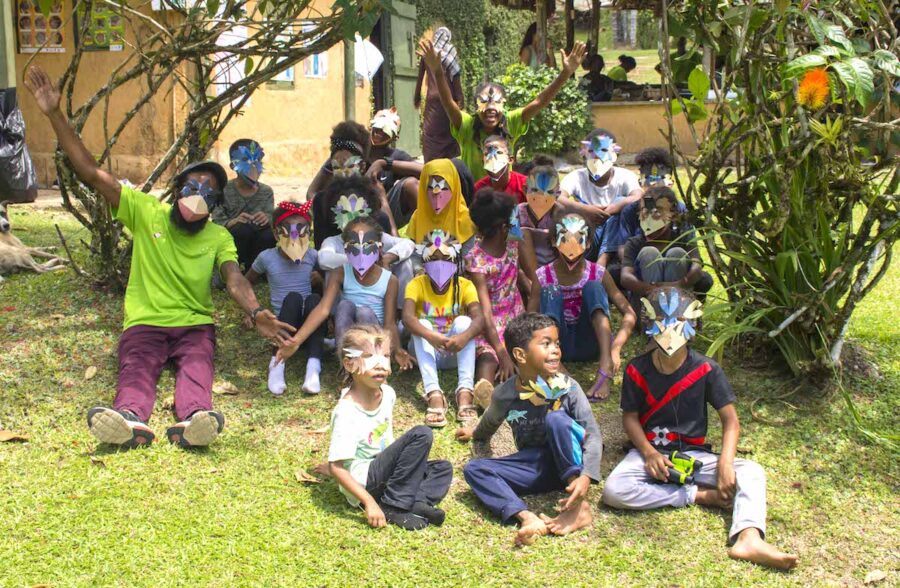
Still the Best in the West (Indies)
The Endemic Birds of the West Indies Coloring Book was again a favorite among participants across the islands. Since its release, island coordinators have used the book as a tool to introduce youth to the fascinating world of birds. Both English and Spanish versions of the coloring book are available for free download from our Resources page! Contact info@Birdscaribbean.org to find out how to receive printed copies of English or Spanish books.
We intend to share this valuable educational resource in French, but this can only be made possible with your help! Your support ensures that our resources, which help both adults and children learn about birds and how to protect them, remain free and accessible.
If you would like to donate, please click here.
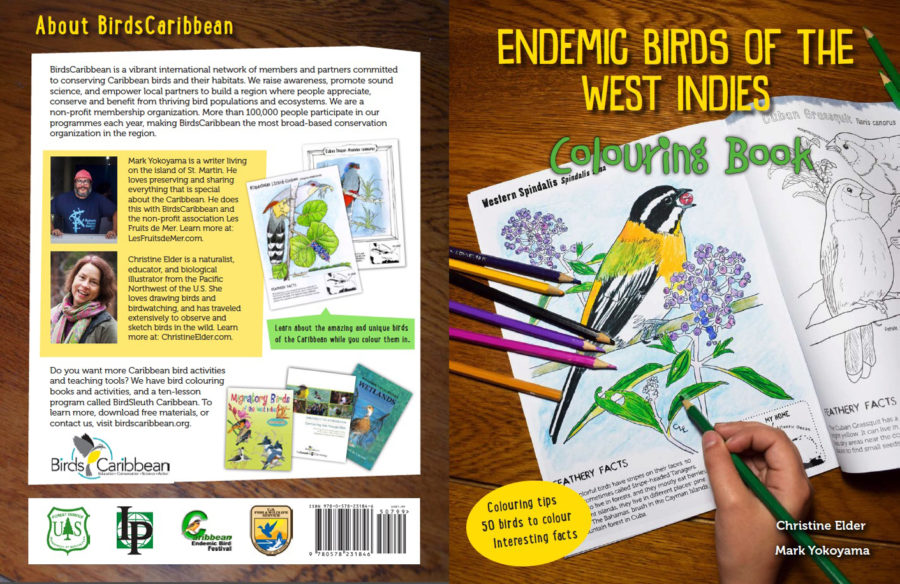
Feathery facts and free resources for classrooms and homes
Each day we featured a new Endemic Bird of the Day on our website and across BirdsCaribbean’s socials, sharing 26 new species in 2023. The species were carefully selected to include truly unique birds, like the Martinique Oriole and Gray-crowned Palm-Tanager; species which keep birders’ ID skills in check, like the Lesser Antillean Swift; those that challenge female stereotypes, like the Ashy-faced Owl; and endemic crooners, like the Rufous-throated Solitaire and Bahama Mockingbird. You can find the complete library of 131 endemic birds covered thus far here. (There are ~180 endemic birds total in the region with 5 “new” species added via species splits in July 2023!).
Each endemic bird profile was accompanied by a beautifully drawn image by Josmar Esteban Marquez of AveZona, stunning high quality photos and videos, online puzzles tailored for different levels (between six and 1,024 pieces), and bird calls. Fun, free and engaging activities were also provided for both kids and adults, including downloadable coloring pages, experiments, up-cycle crafts, and more.
CEBF 2024 loading…
This year’s CEBF is over – but don’t worry, we still have plenty of bird content for you to enjoy! Make sure you are following us on Facebook, Instagram, Twitter, and LinkedIn, and have joined the BirdsCaribbean mailing list, to ensure you are kept up to date with our latest news via our monthly newsletter.
The Caribbean Endemic Bird Festival will return next April 2024 – but we need help coming up with a theme! We would love to hear your ideas for next year’s theme, which should allow us to highlight a critical problem that affects birds throughout the region. Please email your theme and a brief explanation (1-3 sentences) on why it should be the 2024 CEBF theme to CEBF@birdscaribbean.org, info@birdscaribbean.org and Aliya.Hosein@birdscaribbean.org
And, we need help distributing educational materials to our partners in the Caribbean for next year’s CEBF.
In addition to high shipping costs, it can be difficult to get the materials to individual islands on-time and in good condition. If you, or a friend or relative, will be traveling between the US and the Caribbean during the months of December, January and February and have extra room in your suitcase, please get in touch with us at CEBF@birdscaribbean.org, info@birdscaribbean.org and Aliya.Hosein@birdscaribbean.org. Your support will help ensure that bird education remains accessible to all in the Caribbean.
Acknowledgements: A massive THANK YOU to the island coordinators for your enthusiasm and dedication to making this another memorable CEBF! Each year we see a growing number of participants committed to increasing their knowledge of Caribbean birds and actively working to protect their habitats. We also extend our gratitude to our donors and members who help us provide the coordinators with the support and resources they need to educate and inspire future generations of bird and nature loving communities.

